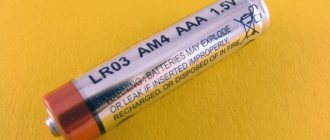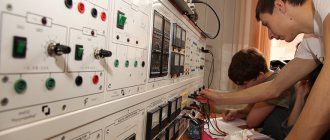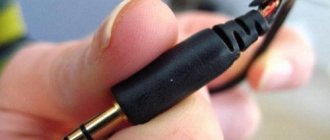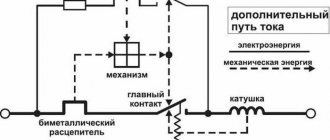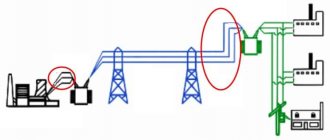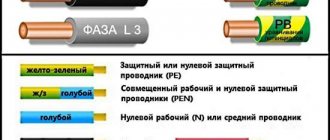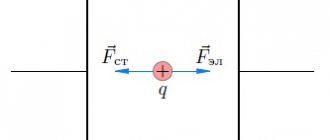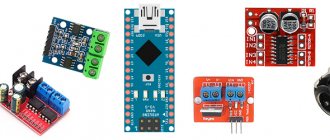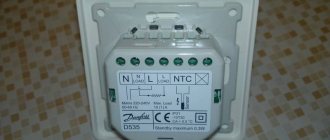In order to start working with microcontrollers such as Arduino or Iskra JS, you need to gradually improve your knowledge in such an area as electricity.
Let's start with the basics. I will try to add some translations of definitions into English, which will be useful in further work with boards.
Electricity is some movement of electrons under the influence of an electromagnetic field. Electricity refers to the energy of very small charged particles that move inside conductors in a specific direction. To better understand the concept of electricity, you should consider its basic concepts.
Electricity concept
All substances are made up of molecules, which in turn are made up of atoms.
An atom has a nucleus and positively and negatively charged particles (protons and electrons) moving around it. When two materials are located next to each other, a potential difference arises between them (the atoms of one substance always have fewer electrons than the other), which leads to the appearance of an electric charge - electrons begin to move from one material to another. This is how electricity is created. In other words, electricity is the energy resulting from the movement of negatively charged particles from one substance to another. The speed of movement may vary. To ensure movement is in the right direction and at the right speed, conductors are used. If the movement of electrons through a conductor is carried out in only one direction, such a current is called constant. If the direction of movement changes with a certain frequency, then the current will be alternating. The most famous and simple source of direct current is a battery or car battery. Alternating current is actively used in households and industry. Almost all devices and equipment work on it.
For your information. The movement of electrical energy can be controlled. Methods of such control are studied in the course “Fundamentals of Electrical Engineering,” which is necessary for all electricians in order to correctly install wiring in the house and prevent fire or injury during work.
D.C
This is the name of a current that does not change the vector of motion over any period of time and is directed strictly from the positive pole to the negative. Constant electric current is characterized by its ability to accumulate - the principle of operation of rechargeable power supplies is based on it.
In addition, such current can be produced in batteries through a chemical reaction. Rechargeable batteries and galvanic batteries power a large number of portable devices. In the diagrams, this type of current is shown by indicating the positive and negative poles. If an electrical appliance is designed to operate only with direct current, the corresponding marking is placed on the body in the form of a single line or a pair of parallel horizontal lines.
Electromagnetism
This phenomenon is one of the basic concepts of electrical engineering. It is a product of the interaction of the magnetic effect and electric current. H. Oersted was the first to record it when the compass approached a cable through which a current was passing: the needle of the device shifted at this time, which illustrated the presence of a magnetic field near the cable.
Electromagnets are materials in which magnetic properties are detected only when current is passed through the winding. To increase the strength of the magnetic field, the winding is made consisting of a large number of turns. The metal base with magnetic properties that is wound around is called the core. The field line vector is determined by the direction of electric current flow in the winding wire. If a magnet exhibits its inherent properties constantly, and not only in the presence of current and winding, it is called permanent. It often has a ring or horseshoe shape.
Alternating current
This is one of the first terms that students of electrical theory are introduced to. At the same time, they learn about its differences from direct current.
This type of current is characterized by the fact that it cyclically changes its magnitude and direction (in contrast to constant current, in which these parameters are unchanged over any time period). In this case, the nature of the changes can be reflected on the graph in the form of a sinusoid. When the lamp is connected to an electrical network with such a current, the minus and plus on its contacts will periodically change places.
The use of such current makes it possible to transmit electrical energy over very long distances. Since generators create enormous voltage, which is dangerous to supply to residential premises, the current from them is sent to substations, where it is transformed.
For your information. From this current you can obtain a constant current using a rectifying device - a diode bridge. It straightens a sine curve, which causes electrons to move in the same vector without changing over time.
Units
One of the main characteristics of such a current is frequency - a value indicating the number of incidents of parameter changes per unit time. It is denoted as f and measured in hertz (Hz). Most often, a frequency of 50 Hz is used for domestic and industrial needs. This means that the poles on the two socket terminals change positions 50 times per second.
A period is the time during which a single incident of change occurs. If there are 50 of them per second, then the period will be equal to 0.02 s.
The effective value of the current is the generation of heat for a certain resistance equal to a certain alternating current for a given time.
Transformers
These are devices that convert alternating electric current with given parameters into a current with a different voltage, but identical to the original frequency. Their action is based on the principle of mutual induction. The device is static, not equipped with moving elements, and therefore is not a machine, but students become familiar with its operation at the same time as the principles of operation of electrical machines.
The device contains two coils with an unequal number of turns (this is done to ensure a voltage difference). The magnetic field transfers electricity between the coils.
Electrical machines (electric motors and generators)
These mechanisms are widely used in automation, industry, and are the main elements of electrical installations. Two main types, differing in purpose and mode of operation, are generators and motors. Any machine includes a stable part (stator) and a moving part (rotor).
Electromagnetic field
Definition 1
An electromagnetic field is a type of matter through which electromagnetic interaction is produced between particles with an electric charge. This is a type of matter that transmits the actions of electromagnetic forces.
Electricity is the concept of an electromagnetic field. It is worth remembering that the term “field” in physics is used to designate a number of concepts that are different in content, which include the following:
- The word “field” fully characterizes the distribution of any physical quantity, scalar or vector. When studying, for example, the thermal state at different points of the medium, a scalar temperature field is reported. When considering the process of mechanical vibrations in an elastic medium, we are talking about a mechanical wave field. In these examples, the concept of “field” describes the physical state of the material environment being studied.
- A special type of matter is also called a field. The term field (as a type of matter) appeared due to the general problem of interaction. The theory where the action of forces is transmitted through a common void instantly is called the theory of long-range action. The theory that states that the action of forces is transmitted at a finite speed through an intermediate material medium is called the theory of short-range action.
Finished works on a similar topic
Course work Electricity as a branch of physics 450 ₽ Abstract Electricity as a branch of physics 230 ₽ Test paper Electricity as a branch of physics 190 ₽
Receive completed work or specialist advice on your educational project Find out the cost
Electric and magnetic fields are usually considered separately, although in reality there are no “purely” magnetic or “purely” electrical phenomena. There is only one single electromagnetic process. The division of electromagnetic interaction into magnetic and electric, as well as the division of unified electromagnetic forces into magnetic and electric, is conditional, and such a conditionality can be easily proven. The terminology – “magnetic”, “electric” forces – is just as conventional.
What does electrical engineering study?
Radio engineering for beginners
This science knows almost everything about electricity. It is necessary for anyone who wants to obtain a diploma or qualification as an electrician to study it. In most educational institutions, the course in which everything related to electricity is studied is called “Theoretical Foundations of Electrical Engineering” or, abbreviated as TOE.
This science was developed in the 19th century, when a direct current source was invented, and it became possible to build electrical circuits. Electrical engineering received further development in the process of new discoveries in the field of physics of electromagnetic radiation. In order to master science without problems at the present time, it is necessary to have knowledge not only in the field of physics, but also chemistry and mathematics.
First of all, in the TOE course the basics of electricity are studied, the definition of current is given, its properties, characteristics and areas of application are explored. Next, electromagnetic fields and the possibilities of their practical use are studied. The course usually ends with the study of devices that use electrical energy.
Subject of Study Electrical Engineering
To understand electricity, you don’t have to go to a higher or secondary educational institution; it’s enough to use a self-instruction manual or take video lessons “for dummies.” The knowledge gained is quite enough to deal with wiring, replace a light bulb or hang a chandelier at home. But, if you plan to work professionally with electricity (for example, as an electrician or power engineer), then appropriate education will be mandatory. It allows you to obtain a special permit to work with instruments and devices operating from a current source.
Electrical Facts in History
Electrical phenomena have been known since ancient times, among them the following facts can be distinguished:
- Around 500 BC e. Thales of Miletus discovered that amber rubbed with wool easily attracts light fluff. Even his daughter, when cleaning an amber spindle with wool, saw this effect. The word “electron” is translated from Greek as “amber”, hence the term “electricity”. This concept was introduced by V. 16th century English physician Gilbert. After a series of experiments, he discovered that a number of substances become electrified.
- Clay vessels were discovered in Babylon (4000 years ago) containing copper and iron rods. At the bottom there was bitumen, which insulates the material. The rods were separated by acetic or citric acid, that is, this find is reminiscent of a galvanic cell. Gold on Babylonian jewelry was applied by electroplating.
Are you an expert in this subject area? We invite you to become the author of the Directory Working Conditions
Automatic protection systems
The power grid carries 2 types of threats:
- The power of household wiring is sufficient to ignite materials used in finishing premises. A short circuit in the network leads to an uncontrolled increase in current strength and ignition. It is impossible to reduce the likelihood of such a situation to zero, but it is reduced by introducing a circuit breaker into the circuit. When the current parameters increase, the device plate is deformed, a spring is released, which opens the contacts. The machine does not respond to starting current pulses.
- The neutral wire is connected to the ground, the phase wire is energized in relation to it. A current arises between such a conductor and grounded objects. There is practically no risk of injury to a person by electricity generated between 2 network cables. However, under certain conditions of current flow, electrical injury becomes fatal. Automatic protection systems ensure that current enters one wire and leaves through the other. When voltage appears between the phase and a grounded object, for example, a human body, the RCD de-energizes the network.
Basic concepts of electrical engineering
When studying electricity for beginners, the main thing is to understand three basic terms:
- Current strength;
- Voltage;
- Resistance.
Current strength refers to the amount of electric charge flowing through a conductor with a certain cross-section per unit of time. In other words, the number of electrons that have moved from one end of a conductor to the other over time. The current strength is the most dangerous for human life and health. If you grab a bare wire (and a person is also a conductor), then electrons will pass through it. The more of them that pass, the greater the damage will be, since as they move they generate heat and trigger various chemical reactions.
However, for current to flow through conductors, there must be a voltage or potential difference between one end of the conductor and the other. Moreover, it must be constant so that the movement of electrons does not stop. To do this, the electrical circuit must be closed, and at one end of the circuit a current source must be placed, which ensures the constant movement of electrons in the circuit.
Resistance is a physical characteristic of a conductor, its ability to conduct electrons. The lower the resistance of the conductor, the more electrons will pass through it per unit time, the higher the current. High resistance, on the contrary, reduces the current, but causes the conductor to heat up (if the voltage is high enough), which can lead to a fire.
Selection of optimal relationships between voltage, resistance and current in an electrical circuit is one of the main tasks of electrical engineering.
Concepts and properties of electric current
Electricity is the movement of particles that carry charge. This does not happen when free electrons move randomly. Only orderly moving particles participate in the movement of charge. The current always flows directionally. The following signs indicate its presence:
- increase in conductor temperature;
- force impact on magnetized bodies;
- change in the chemical properties of the conductor.
Current can be alternating or constant. In the second case, its parameters are unchanged. Alternating current periodically changes polarity from negative to positive. This means that the direction of particle flow becomes opposite. The rate of change is frequency.
Current strength
When electricity appears in the circuit, charge is transferred through the cross-section of the conductor. The amount passed per unit time is called current strength and is expressed in amperes.
Voltage
To maintain the movement of charge-carrying particles, a force acting in the desired direction is required. It is called electric field or intensity. The force causes a potential difference and stimulates the movement of particles. To measure voltage, a separate unit is used - volts. There is a relationship between the main parameters of the current, reflected in Ohm's law.
Resistance
This quantity is a characteristic of the conductor associated with current. Resistance, expressed in ohms, denotes the resistance of a material to the flow of charged particles. The parameter increases as the cross-section decreases and the length of the conductor increases. Under the influence of resistance, the material heats up. A value of 1 ohm occurs at a current of 1 A and a voltage of 1 V.
Current power
Electrical current is used to do work - heating batteries, rotating a motor, etc. You can calculate power in watts by multiplying the current by the voltage. For example, a heater operating from a 220 V network consumes 2200 W. This means that it requires a power of 10 A to function. A 100 W incandescent lamp consumes 0.45 A.
Energy and power
A novice electrician must learn to understand such concepts. Energy can be electrical, thermal, mechanical or nuclear. It cannot be created or destroyed. One type of energy can be transformed into another. For example, in household appliances, electricity is converted into heat or sound. Any device consumes a certain amount of energy over a given period of time.
Each device is characterized by its own value, which is power.
Starting current
It is necessary to distinguish between the parameters of the current consumed by the device when it is operating and when it is turned on. In the latter case, there is a jump that is many times higher than the operational indicators. The current arriving at the moment of switching on is called starting. Electric motors have the largest parameter. The starting current is supplied until the shaft reaches the required rotation speed. This is typical for most household appliances. Power supplies are equipped with devices that store energy for startup.
The inrush current is not typical for low-power heating elements. It will not be possible to calculate the parameter knowing the power of the device. Devices have different ratios. In addition, modern devices are equipped with inrush current limiters.
Ohm's law
Current is equal to voltage divided by resistance. This is the main point of Ohm's law. It operates on direct and alternating current. A current of 1 A passes through a wire with a resistance of 1 Ohm at a voltage of 1 V. Two consequences follow from Ohm’s law:
- Given the current and resistance, the power delivered by the circuit can be calculated. To do this, the square of the first parameter is multiplied by the second.
- Given the voltage and resistance, the power can be calculated. In this case, the square of the first value is divided by the value of the second.
Coulomb's law
According to a short description, this is a physical law that talks about the interaction between directly standing point electric charges, depending on the distance at which they are located. According to the full definition, the formulation means that a vacuum is formed between two points in the form of electric charges. A specific force appears there, which is proportional to the multiplication of their modular particles divided by the square of the distance.
Distance is the length that connects charges. The interaction force is directed along the segment. Coulomb force is a force that is repulsive for charges minus-minus and plus-plus and attractive for charges minus-plus and plus-minus.
Note! The electric force formula looks like this: F=k⋅|q1|⋅|q2|/r2, where F is the force of the charge, q is the magnitude of the charge, r is the vector or distance between charges, and k is the proportionality coefficient. The latter is equal to c2·10−7 H/m.
Coulomb's law
Solving a problem with Coulomb's law. If you have charged balls that are located at a distance of 15 cm and repel with a force of 1 N in search of the initial charge, you can identify the unknown by converting the base units to the SI system and substituting the values into the indicated formula. The value will be 2 * 5 * 10 (-8) = 10 (-7).
Gauss's theorem
The fundamental law in electrodynamics, included in Maxwell's equations. This is a consequence of the Coulomb inference and the principle of superposition. Along it, the field voltage vector moves through an arbitrary value of a closed surface surrounded by charges. It is proportional to the sum of charged particles that are inside this closed space. The specified vector is divided by e0. All this is expressed by the formula below.
Gauss's theorem
Capacitance of parallel plate capacitor
Capacitance is a conductive characteristic through which an electric charge can accumulate energy. A flat capacitor is a series of oppositely charged plates separated by a thin dielectric layer. The capacitance of a flat capacitor is considered to be its characteristic, its ability to accumulate electrical energy.
Note! This is a physical quantity that is equal to the charge divided by the potential difference of its plate. The charge in this case is one charged plate.
If the problem requires finding out the capacitance of a capacitor made of two plates with an area of 10(-2) square meters and there is a 2*10(-3) meter sheet in them, ε0 is the electric constant with 8.85×10-12 farads per meter and ε =6 is the dielectric constant of mica. In this case, you need to insert the values into the formula C= ε* ε* S/d.
Capacitance of parallel plate capacitor
Energy of a parallel plate capacitor
Since any particle of a capacitor has the ability to store energy, which is stored on the capacitor plate, calculating this very E is simple, since in order for the element to charge, it needs to do work. The work is done by the field. As a result, the following formula was derived: Ep = A = qEd, where A is the work, d is the distance.
Energy
Electrical engineering and electromechanics
Electromechanics is a branch of electrical engineering. She studies the principles of operation of devices and equipment that operate from a source of electrical current. By studying the basics of electromechanics, you can learn how to repair various equipment or even design it.
As part of lessons in electromechanics, as a rule, the rules for converting electrical energy into mechanical energy are studied (how an electric motor functions, the principles of operation of any machine, and so on). Reverse processes are also studied, in particular, the principles of operation of transformers and current generators.
Thus, without understanding how electrical circuits are composed, the principles of their functioning and other issues that electrical engineering studies, it is impossible to master electromechanics. On the other hand, electromechanics is a more complex discipline and is of an applied nature, since the results of its study are directly used in the design and repair of machines, equipment and various electrical devices.
Safety and Practice
When mastering an electrical engineering course for beginners, it is necessary to pay special attention to safety issues, since failure to comply with certain rules can lead to tragic consequences.
The first rule to follow is to read the instructions. All electrical appliances always have a section in their instruction manual that deals with safety issues.
Important! Following the recommendations will help avoid injury and damage to property.
The second rule is to monitor the condition of the conductor insulation. All wires must be covered with special materials that do not conduct electricity (dielectrics). If the insulating layer is damaged, first of all it should be restored, otherwise harm to health may occur. In addition, for safety reasons, work with wires and electrical equipment should only be done in special clothing that does not conduct electricity (rubber gloves and dielectric boots).
The third rule is to use only special devices to diagnose electrical network parameters. Under no circumstances should you do this with your bare hands or try it on your tongue.
Note! Neglect of these basic rules is the main cause of injuries and accidents in the work of electricians and electricians.
Kirchhoff's laws
The electrical work of any room is carried out in the form of closed, working electrical circuits. The two main laws that determine processes in electrical networks are Kirchhoff's laws. There are two of them. Both of them apply to both direct and alternating currents.
Kirchhoff's first law states:
The total value of currents directed to an electrical network node is equal to the total value of currents directed from the node.
In practice, the operation of Residual Current Devices (RCDs) is based on Kirchhoff's first law. The operation of the RCD is to turn off the power supply to the network when leakage currents occur. During normal operation, the total value of the current flowing into the electrical network is equal to the value of the current flowing out of it. If the equality of currents is violated, then there is a leak in the network. The RCD is designed and connected in such a way that if there is a current leak, the RCD detects it and disconnects the power supply.
Kirchhoff's second law states:
Any closed loop of an alternating electrical network has equal values of complex voltages and EMF (electromotive forces) on all passive elements of the network.
Note: Complex voltage is the value of AC mains voltage.
Practical application can be explained on any apartment power supply group. For clarification, let's look at an apartment.
No matter how many power supply groups there are in the apartment, at any outlet or lamp the voltage in the network (in operating mode) will be 220 volts.
Three-phase network
A three-phase network is a method of transmitting current when alternating current passes through three wires and only one returns back. Absolutely any electrical circuit has two wires. Through one of them, the current goes to the user (for example, the current goes to a kettle), and through the other, it returns back. If you open such a circuit, the current simply will not flow.
The wire through which the current follows is called phase (often called simply phase), and the one through which it returns is called zero (called zero). A three-phase circuit consists of three phase wires and one return wire. This becomes possible because the phase of the alternating current in each of these three wires is shifted relative to the neighboring one by 120 °C.
The transmission of alternating current is carried out thanks to three-phase networks. This is extremely convenient and economically beneficial - it does not require two more neutral wires. Approaching the user, the current is divided into 3 phases, and each of them is given zero. This is how it is supplied to apartments and houses. Sometimes a three-phase network goes directly into the house. This happens most often in the private sector.
Formulas for direct electric current
A direct electric current does not change in magnitude or direction. It is used to calculate a closed, homogeneous circuit, power and other parameters. Therefore, it is important to know the formulas for it and the basic laws associated with it.
Ohm's law for a section of a homogeneous chain
For electric current to exist, a field is needed. For its formation, potentials or their difference, expressed by voltage, are needed. The current will be directed towards reducing the potentials, and the electrons will begin to move in the opposite direction. In 1826, G. Ohm conducted a study and concluded: the higher the voltage, the greater the current that passes through the section.
For your information! Adjacent conductors conduct electricity differently. That is, each element has its own conductivity, electrical resistance.
As a result, according to Ohm’s theorem, the current strength for a section of a homogeneous circuit will be directly proportional to the voltage across it and inversely proportional to the conductive resistance.
Ohm's law
Using the formula I = U / R, where I is considered to be the current strength, U is the voltage, and R is the electrical resistance, the latter value can be found if p * l / S, where p is the conductor resistivity, l is the length of the conductor, and S — cross-sectional area of the conductor.
Ohm's law for a closed circuit with a current source
Ohm made a formula for a closed circuit. According to it, the current in this section from a current source having internal and external load resistance is equal to dividing the electromotive force of the source by the sum of the internal and external resistance. It looks like this: I = e / R + r, where I is the current force, e is the emf, R is the resistance, and r is the internal resistance of the voltage source.
Note! In the physical sense, according to this law, the higher the EMF, the higher the source of energy, the greater the speed of movement of charges. The higher the resistance, the lower the current.
Ohm's law for a closed circuit
DC operation
Energy, when passed through a conductor, moves in an orderly manner into the carrier. While moving, it does work. As a result, direct current work is the field activity aimed at transferring electrical charges along a conductor. It is equal to I multiplied by the voltage and time performed by the work.
Joule-Lenz law
When electricity passes through any resistive conductor, heat is always released. The amount of heat released over a certain period of time is determined by the Joule-Lenz law. According to the formula, the heat power is equal to the electricity density multiplied by the voltage - w =j * E = oE(2).
Note! In practical terms, the law is important for reducing electricity loss, selecting a conductor for an electrical circuit, selecting an electric heating device and using a fuse to protect the network.
Joule-Lenz law
Grounding
Grounding is the third wire in a single-phase network. At its core, it does not carry any workload, but for the most part acts as a reliable fuse.
In a situation where the electrical network suddenly goes beyond human control (for example, a short circuit), there is a significant threat of fire or electric shock (and therefore a threat to life). In order to prevent this (this means that the total current value should not be higher than a level that is safe for people and devices), grounding is introduced. Through this wire, excess electric current literally goes into the ground.
Installation of the ground loop
For example, a small breakdown occurs in the operation of the electric motor of a washing machine, and some of the electricity reaches the outer metal part of this device. If there were no grounding in that case, this charge would wander around this washing machine. And when a person touches it, he will instantly become a convenient outlet for this kind of energy, which means he will receive an electric shock.
If there is a ground wire, in this case the excess charge will flow down it without causing harm to anyone. The neutral conductor is also capable of playing the role of grounding and, in principle, is one, but only at a power plant.
We must remember that any situation where there is no grounding in the house is unsafe.
